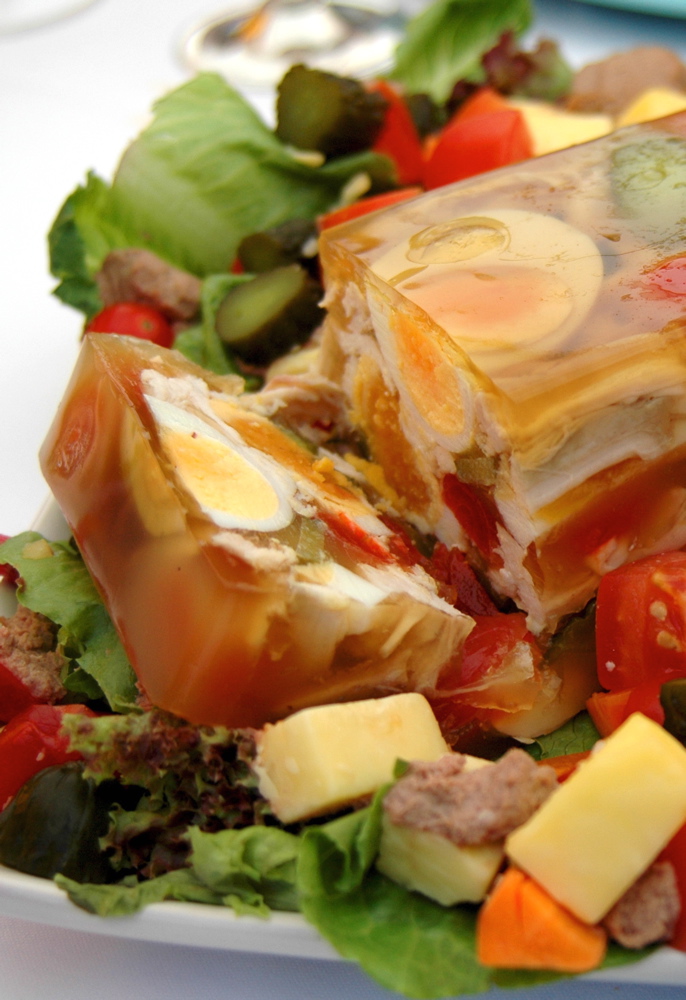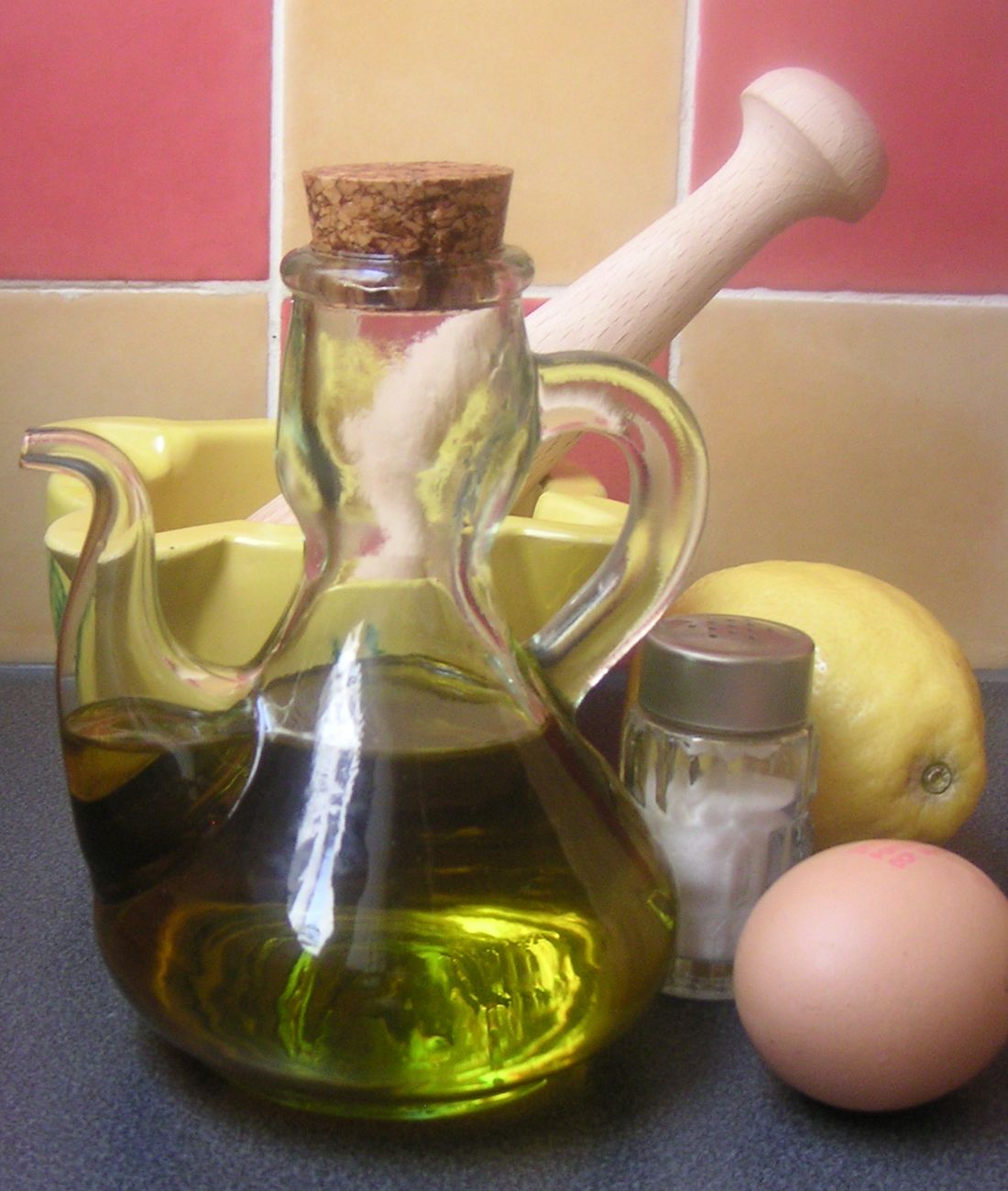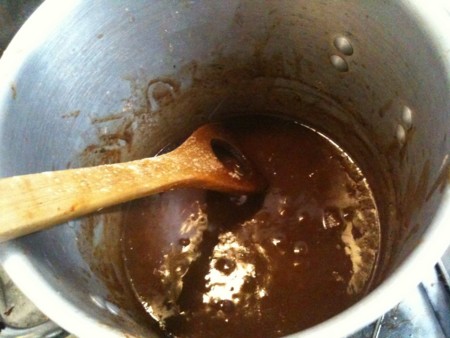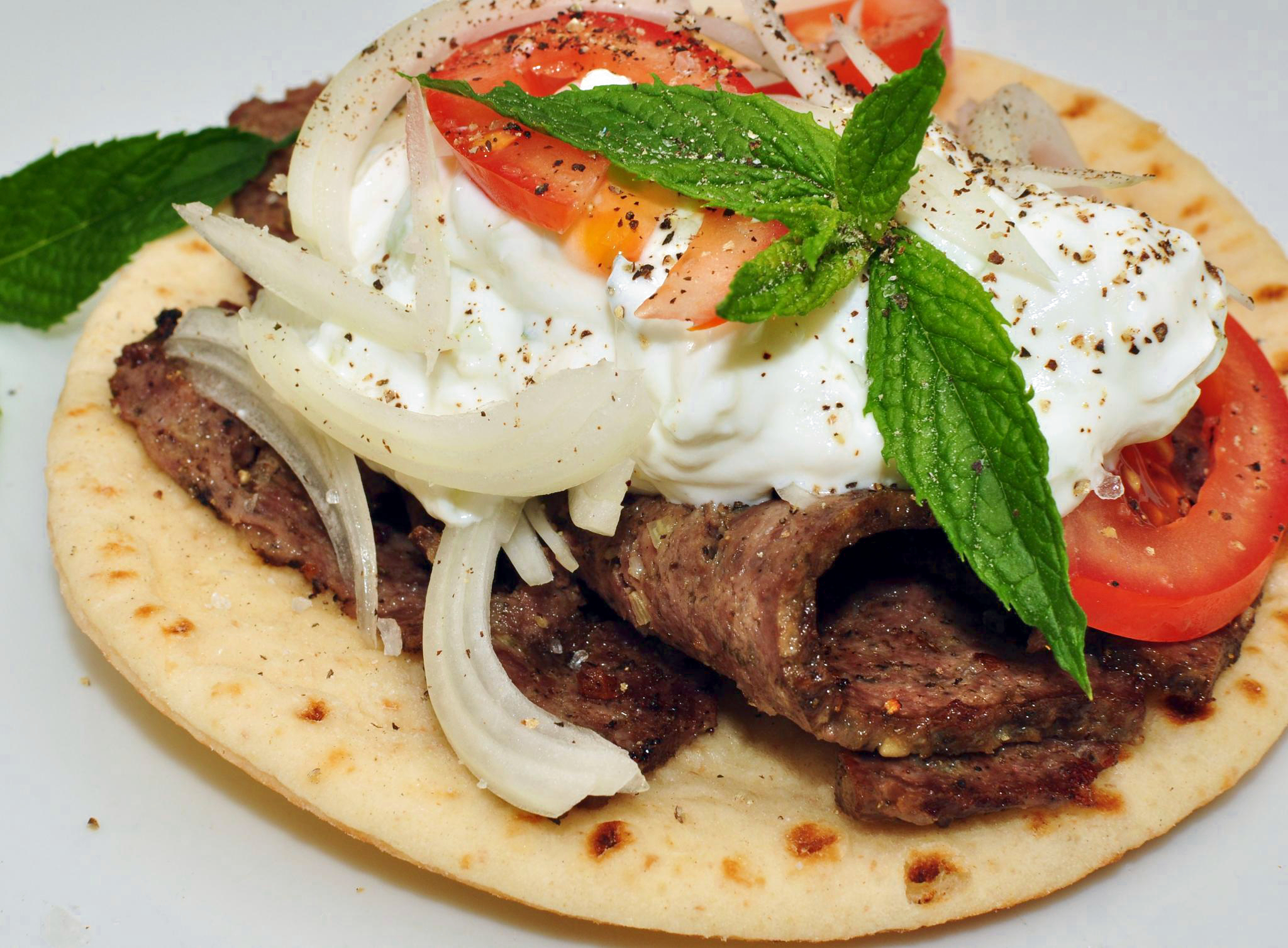|
Chaudfroid
Chaudfroid sauce, also spelled as chaud-froid sauce, is a culinary sauce that can be prepared using a reduction of boiled meat carcasses and other ingredients. Simpler preparations of the sauce omit the use of meat, with some variations using sauces such as espagnole, allemande or velouté as a base. Chaudfroid sauce is typically served cold, atop cold meats and cold meat-based dishes such as galantine and terrine. Etymology The term "chaud froid" means "hot-cold" in French. The sauce's name is based upon the sauce being prepared hot, but served cold. History It has been suggested that chaudfroid sauce was invented by Louis-Alexandre Berthier (20 November 1753 – 1 June 1815) of France, during Berthier's time under Napoleon. Overview Chaudfroid sauce is a culinary sauce or gravy that can be prepared as a meat-based sauce by boiling the carcasses or bones of game meats or other meats such as poultry with herbs and spices. Vegetables such as onion and carrot have also been u ... [...More Info...] [...Related Items...] OR: [Wikipedia] [Google] [Baidu] |
List Of Sauces
The following is a list of notable Culinary art, culinary and prepared sauces used in cooking and food service. General * * * * * * * * * * * * * * * * * * * – Creamy sauce accompanies with seafood * * * * * * * (salsa roja) * * * – a velouté sauce flavored with tomato * * – prepared using mushrooms and lemon * * * * * * * * Prepared sauces * * * * * * * * * * * * * * * * * By type Brown sauces include: * * * * * * * * * * * Butter sauces * * * – Butter emulsified with water * Beurre noisette – Brown butter sauce * * Emulsified sauces * * * * * * * * * (w/ chilli) Fish sauces * * * * Green sauces * See Tomato sauces * * Hot sauces * Pepper sauces *Mustard sauces ** * Chile pepper-tinged sauces * Condiments made from hot sauce include: ** ** ** sauce ** sauce ** ** ** Meat-based sauces * * * * * * * * Pink sauces * See Pink sauce (disamb ... [...More Info...] [...Related Items...] OR: [Wikipedia] [Google] [Baidu] |
Aspic
Aspic () or meat jelly is a savoury gelatin made with a meat stock (food), stock or broth, set in a mold to encase other ingredients. These often include pieces of meat, seafood, vegetable, or eggs. Aspic is also sometimes referred to as ''aspic gelée'' or ''aspic jelly''. In its simplest form, aspic is essentially a gelatinous version of conventional soup. History According to one poetic reference by Ibrahim ibn al-Mahdi, who described a version of a dish prepared with Iraqi carp, it was "like ruby on the platter, set in a pearl ... steeped in saffron thus, like garnet it looks, vibrantly red, shimmering on silver". Historically, meat aspics were made even before fruit- and vegetable-flavoured aspics. By the Middle Ages, cooks had discovered that a thickened meat broth could be made into a jelly. A detailed recipe for aspic is found in ''Le Viandier'', written in or around 1375. In the early 19th century, the French chef Marie-Antoine Carême created chaudfroid. The term ''ch ... [...More Info...] [...Related Items...] OR: [Wikipedia] [Google] [Baidu] |
Sweetbread
Sweetbread is a culinary name for the thymus or pancreas, typically from calf or lamb. Sweetbreads have a rich, slightly gamey flavor and a tender, succulent texture. They are often served as an appetizer or a main course and can be accompanied by a variety of sauces and side dishes. The etymology of the name is unclear. Description Sweetbread is a culinary name for the thymus (also called throat, gullet, or neck sweetbread) or pancreas (also called stomach, belly or heart sweetbread), typically from calf () or lamb (). Sweetbreads have a rich, slightly gamey flavor and a tender, succulent texture. The "heart" sweetbreads are more spherical, while the "throat" sweetbreads are more cylindrical. As the thymus is replaced by fibrous tissue in older animals, only pancreatic sweetbreads come from beef and pork. Like other edible non-muscle from animal carcasses, sweetbreads may be categorized as offal, "fancy meat", or "variety meat". Various other glands used as food may als ... [...More Info...] [...Related Items...] OR: [Wikipedia] [Google] [Baidu] |
Mayonnaise
Mayonnaise (), colloquially referred to as "mayo" (), is a thick, creamy sauce with a rich and tangy taste that is commonly used on sandwiches, hamburgers, Salad#Bound salads, bound salads, and French fries. It also forms the base for various other sauces, such as tartar sauce, fry sauce, remoulade, salsa golf, ranch dressing, and rouille. Mayonnaise is an emulsion of Edible oil, oil, egg yolk, and an acid, either vinegar or lemon juice; there are many variants using additional flavorings. The color varies from near-white to pale yellow, and its texture from a light cream to a thick gel. Commercial eggless versions are made for those who avoid chicken eggs because of egg allergies, to limit cholesterol, dietary cholesterol, or because they are vegetarian or Veganism, vegan. History ''Mayonnaise'' is a French cuisine appellation that seems to have appeared for the first time in 1806. The hypotheses invoked over time as to the origin(s) of mayonnaise have been numerous and c ... [...More Info...] [...Related Items...] OR: [Wikipedia] [Google] [Baidu] |
Kirsch
''Kirschwasser'' (, , ; German for 'cherry water'), or just ''Kirsch'' (; the term used in Switzerland and France, less so in Germany), is a clear, colourless brandy from Germany, Switzerland, and France, traditionally made from double distillation of morello cherries. It is now also made from other kinds of cherries. The cherries are fermented completely, including their stones.Lichine, Alexis. ''Alexis Lichine's New Encyclopedia of Wines & Spirits'' (New York: Alfred A. Knopf, 1987), p. 292. Unlike cherry liqueurs and cherry brandies, ''Kirschwasser'' is not sweet. It is sometimes distilled from fermented cherry juice. Serving ''Kirschwasser'' is usually drunk neat. It is traditionally served cold in a very small glass and is taken as an apéritif. It is an important ingredient in fondue. People in the German-speaking region where it originated usually serve it after dinner, as a digestif. ''Kirschwasser'' is used in some cocktails, such as the Ladyfinger, the Florid ... [...More Info...] [...Related Items...] OR: [Wikipedia] [Google] [Baidu] |
Purée
A purée (or mash) is cooked food, usually vegetables, fruits or legumes, that has been ground, pressed, blended or sieved to the consistency of a creamy paste or liquid. Purées of specific foods are often known by specific names, e.g., apple sauce or hummus. The term is of French origin, where it meant in Old French (13th century) ''purified'' or ''refined''. Purées overlap with other dishes with similar consistency, such as thick soups, creaming (food), creams (''crèmes'') and gravy, gravies—although these terms often imply more complex recipes and cooking processes. ''Coulis'' (French for "strained") is a similar but broader term, more commonly used for fruit purées. The term is not commonly used for paste-like foods prepared from cereal flours, such as gruel or muesli; nor with oily nut pastes, such as peanut butter. The term "paste" is often used for purées intended to be used as an ingredient, rather than eaten immediately. Purées can be made in a blender, or ... [...More Info...] [...Related Items...] OR: [Wikipedia] [Google] [Baidu] |
White Sauce
White is the lightest color and is achromatic (having no chroma). It is the color of objects such as snow, chalk, and milk, and is the opposite of black. White objects fully (or almost fully) reflect and scatter all the visible wavelengths of light. White on television and computer screens is created by a mixture of red, blue, and green light. The color white can be given with white pigments, especially titanium dioxide. In ancient Egypt and ancient Rome, priestesses wore white as a symbol of purity, and Romans wore white togas as symbols of citizenship. In the Middle Ages and Renaissance a white unicorn symbolized chastity, and a white lamb sacrifice and purity. It was the royal color of the kings of France as well as the flag of monarchist France from 1815 to 1830, and of the monarchist movement that opposed the Bolsheviks during the Russian Civil War (1917–1922). Greek temples and Roman temples were faced with white marble, and beginning in the 18th century, wi ... [...More Info...] [...Related Items...] OR: [Wikipedia] [Google] [Baidu] |
Brown Sauce
Brown sauce is a condiment that is normally dark brown in colour. Its taste is either tart or sweet with a peppery note similar to that of Worcestershire sauce. A.1. Sauce was the first brown sauce and was introduced in 1831. Description Brown sauce is a condiment commonly served with food in the United Kingdom and Ireland. It is normally dark brown in colour. The taste is either tart or sweet with a peppery taste similar to that of Worcestershire sauce. Commercial sauces are a blend of tomatoes, malt vinegar, molasses, dates, spices and tamarind. Use Brown sauce is typically eaten with meals such as meat pies, full breakfasts, bacon sandwiches and chips. A combination of malt vinegar (or water) and brown sauce known simply as sauce or chippy sauce is popular on fish and chips in Edinburgh. History The first brown sauce—Brand's A.1. sauce—was introduced in 1831. It was made in Vauxhall, London. In 1837, Yorkshire Relish, of a similar style to brown sauce, ... [...More Info...] [...Related Items...] OR: [Wikipedia] [Google] [Baidu] |
Demi Glace
Demi-glace (, 'half glaze') is a rich brown sauce in French cuisine used by itself or as a base for other sauces. The term comes from the French word ''glace'', which, when used in reference to a sauce, means "icing" or "glaze." It is traditionally made by combining one part espagnole sauce and one part brown stock. The sauce is then reduced by half, strained of any leftover impurities, and finished with a sherry wine. Common variants of demi-glace use a 1:1 mixture of beef or chicken stock to sauce espagnole; these are referred to as "beef demi-glace" (''demi-glace au bœuf'') or "chicken demi-glace" (''demi-glace au poulet''). Preparation Due to the considerable effort involved in making the traditional demi-glace, chefs commonly substitute a simple ''jus lié'' of veal stock or to create a simulated version, which the American cookbook author Julia Child referred to as a "semi-demi-glace" (i.e. sans espagnole sauce). See also * Gypsy sauce * List of sauces * Meat gla ... [...More Info...] [...Related Items...] OR: [Wikipedia] [Google] [Baidu] |
Stock (food)
Stock, sometimes called bone broth, is a savory cooking liquid that forms the basis of many dishes particularly soups, stews, and sauces. Making stock involves simmering animal bones, meat, seafood, or vegetables in water or wine, often for an extended period. Mirepoix or other aromatics may be added for more flavor. Preparation Traditionally, stock is made by simmering various ingredients in water. A newer approach is to use a pressure cooker. The ingredients may include some or all of the following: Bones: Beef and chicken bones are most commonly used; fish is also common. The flavor of the stock comes from the bone marrow, cartilage and other connective tissue. Connective tissue contains collagen, which is converted into gelatin that thickens the liquid. Stock made from bones needs to be simmered for long periods; pressure cooking methods shorten the time necessary to extract the flavor from the bones. Meat: Cooked meat still attached to bones is also used as an ... [...More Info...] [...Related Items...] OR: [Wikipedia] [Google] [Baidu] |
Garnish (food)
A garnish is an item or substance used as a decoration or embellishment accompanying a prepared food dish or drink. In many cases, it may give added or contrasting flavor. Some garnishes are selected mainly to augment the visual impact of the plate, while others are selected specifically for the flavor they may impart. This is in contrast to a condiment, a prepared sauce added to another food item primarily for its flavor. A food item which is served with garnish may be described as being garni, the French term for "garnished." The difference between garnish and decoration, is garnish is edible. For example, plastic grass for sushi presentation is considered a decoration, not a garnish. Overview A garnish makes food or drink items more visually appealing. They may, for example, enhance their color, such as when paprika is sprinkled on a salmon salad. They may provide a color contrast, for example when chives are sprinkled on potatoes. They may make a cocktail more visually ... [...More Info...] [...Related Items...] OR: [Wikipedia] [Google] [Baidu] |







